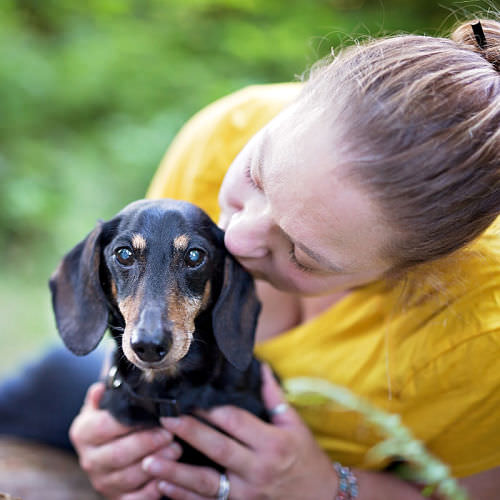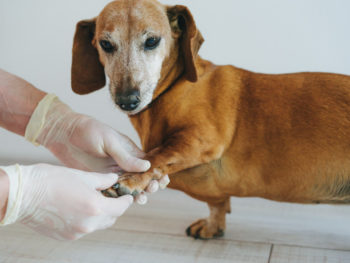There are many reasons people want to get a Dachshund.
They’re adorable. They’re snuggly. They’re small and can go everywhere with you. They are wicked smart.
Did I mention adorable?
But there is one advantage of owning a Dachshund that not many people know when they compare breeds: the Dachshund has a longer life expectancy than many other breeds.
Still, there is a general “upper limit” on age and that can vary quite a bit depending on their genetic health and the quality and quantity of care they receive throughout their lifetime.
You’re want to do everything in your power to give your Dachshund the longest life possible, right?
If so, read on to find out what you can do.
A Dachshund’s lifespan is influenced by the care they receive. Read on to find out what you can do to help ensure yours lives as long as possible.
How Long do Dachshunds Live?
My first Dachshund left us at just shy of 16 years, which is on the higher end of average for this breed and well above their average minimum natural lifespan of 10-11 years.
Over the years, I’ve talked to many Dachshund owners and have heard from many whose dogs lived more than the average.
I regularly hear from people that said their Dachshund lived to be 17 or 18 years old.
The oldest verified Dachshund was a doxie-mix named Chanel from New York, who lived to age 21 and even spent time in the Guinness World Record book as the world’s oldest dog.
Rocky, a Dachshund in Shingle Springs, CA is claimed to have lived to the ripe old age of 25 (almost 26!).
Although the average age of Dachshunds is between 12 and 15 years old, they have the potential to live much longer.
The first thing you’re thinking is probably “how can I get my Dachshund to live that long?”
Some things, like genetics or accidents, are out of your control. But other factors can be influenced by how you raise your Dachshund.
Let’s talk about what issues can afflict Dachshunds and what you can do to increase their lifespan.
Top Causes of Death in Dachshunds
An owner survey conducted by the UK Kennel Club and British Small Animal Veterinary Association Scientific Committee found that the top 5 causes of death for the Dachshund breed are:
- Old Age – 21%
- Cancer – 16.7%
- Cardiac (Heart Disease) 14.3%
- Neurologic (i.e. IVDD, seizures, etc.) – 11%
- Multiple Issue Combinations – 5.7%
Although some of these issues are genetic in nature – meaning that a dog is born with the genes that make them more susceptible to the condition – even those issues can be impacted by how you raise your Dachshund.
How Can Owners Increase Their Dachshund’s Lifespan?
1. Do Your Homework Before Getting Your Dachshund
When people want to know what their Dachshund’s life expectancy is, it’s hard to give an exact number because every dog is different.
Genetics plays a big role in how healthy a dog is and how long they live. However, it’s not the only thing that influences it.
Many people do not realize how much, and what kind of, care a dog receives throughout their life has the potential to significantly impact how long a Doxie lives.
The two main thing that determine how long a Dachshund lives is the genetics they are born with and the care they receive throughout their lifetime. You can influence the latter.
Providing quality care for your Dachshund starts with knowing the breed well.
It’s important to understand the health and behavioral issues are more common in this breed. Be aware of what specific issues and needs you might encounter and be prepared to handle them.
If you choose to get a Dachshund from a breeder, be sure to thoroughly check into the breeder.
Make sure they have a good reputation in the Dachshund community. Look for reviews or testimonials, ask the breeder for references, and talk to some people who have bought puppies from this breeder if you can.
That way you can hear first-hand experiences of what the breeder was like to work with and make sure there were no issues with the puppies after they were brought home.
Also ask the breeder about the parent’s medical history. A good breeder will screen the parents for common health issues and/or have health knowledge about the line a few generations back.
This gives you the best chance of knowing that your dog won’t inherit genes for common health problems in Dachshunds (this is not 100% foolproof but can help assure you your Dachshund will be healthy throughout its lifetime)
Note: Save your impulse purchases for shoes and chocolate. Pets in pet stores come from unknown breeders, most who don’t test the parents for genetic disease before breeding them. (in addition, most pet store puppies come from puppy mills where the dogs’ living conditions are horrific, but that’s another blog story…)
If you can’t find information about a specific breeder, or what you find sounds fishy, continue your search. Generally, Dachshunds from less reputable breeders are not as healthy.
If your dog is coming from a rescue, be sure to research the organization and ask questions.
Does the rescue thoroughly vet the dog to identify and treat medical issues?
Do they provide post-adoption advice/support for any issues that might arise?
Ask about the general situation the dog came from and if the rescue received any health history.
Also ask if the dog has any current medical or behavioral issues that you will need to address.
A rescue may not always be able to provide this information, or the information may be incomplete, but asking can help give your new dog a good start to life with you.
Knowing the breed and making an informed purchase or adoption is a great start, but even dogs with a good health history can develop problems.
Keep reading to learn more you can do to raise the healthiest dog possible.
2. Feed Your Dog a Healthy Diet
How do you know which food(s) are best?
Educate yourself by reading online about different food choices (raw, homemade cooked, and kibble) and different food brands.
You will learn the pros and cons of each choice, as well as ingredients to avoid in store-bought foods.
Choosing a healthy food for your dog will go a long way.
Rotating your Dachshund’s food (periodically switching between different dog foods) can also be beneficial for your dog.
Each dog food has nutritional areas in which it’s not as strong; by switching foods you get the benefits of a variety of meat sources and nutrients.
3. Maintain a Healthy Weight
In addition to feeding your dog a healthy diet, it’s critical to feed the right amounts.
Feeding too much at meals, giving your dog too many treats, and feeding table scraps can all cause your Dachshund to be overweight.
Because Dachshunds are a small dog, becoming overweight happens very quickly and can sneak up on you.
Pet obesity is one of the leading causes of many common diseases and ailments.
When you pet your dog, be aware of their weight: can you feel their ribs?
If you can’t, or if there is quite of bit of skin and fat on top of the ribs, back off on treats or adjust their meals to be slightly smaller.
Your goal is to easily feel the ribs and see a defined waist (think a slight hourglass shape when looking at your dog from the top).
4. Exercise Your Dog on a Regular Basis
A common misconception about Dachshunds is that they don’t need much exercise and that too much exercise can hurt them.
In reality, the opposite is true: making sure your dog gets regular exercise can have a huge positive impact on their health.
Not only can it help keep their weight at an ideal level, it improves cardiovascular fitness and strengthens their core muscles (which help support their long spine).
Just how much exercise does a Dachshund need?
A common belief is that Dachshunds are fragile due their size and long backs. Some people don’t provide enough exercise for their dog because of this and it has a negative affect on their health.
Your general exercise goal should be 30-60 minutes a day for a healthy, adult Dachshund.
Puppies need exercise but you must be careful not to overdo it.
The general rule for puppies is 5 minutes of moderate exercise per month of age.
5. Take Your Dachshund to the Vet Regularly
It goes without saying that seeing a vet on a routine basis will help you prevent health problems by catching any issues early when they are more treatable.
Keeping your dog up to date on vaccines and flea & heartworm preventative will also help fend off disease.
You can do your part at home by checking your Dachshund regularly for any new lumps or bumps and watching for any behavioral changes.
Getting your dog to the vet when you notice sudden changes can increase their lifespan as you can help catch any issues in the early stages.
What is the Dachshund Life Expectancy? It’s up to You!
How you raise your Dachshund can have a profound impact on the average age of your Dachshund.
You may still fight genetics and other things out of your control, and accidents can still happen, but every factor you are able to influence can create a positive impact on your dog’s lifespan.
We all know that no amount of years is long enough for the Dachshund that we love so much.
But, we can create extra moments and extra years by making sure we do everything in our power to give our Dachshund the strongest odds of a long, healthy life.


About the Author: Through her 17 years of owning and caring for Dachshunds, and almost 10 years researching and writing about them, JW has become a respected expert in the Dachshund community. Read more about her here.














 9 Tips for the First Week with Your Dachshund Puppy
9 Tips for the First Week with Your Dachshund Puppy


